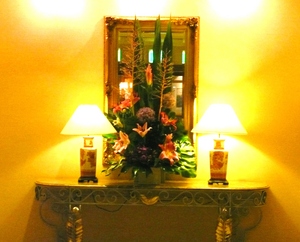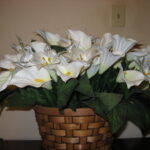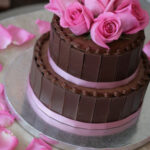With a few basic tools and materials at hand, you can create stylish looking flower displays with ease.
Instant flower arrangements are created by simply placing flowers in a vase. But when you want a rather more creative display, there is a wide choice of flower supports available to help you achieve the right effect.
For an elaborate dried flower swag or a formal wedding arrangement, you need various wiring materials. Follow these guidelines to equip yourself with everything you need to create any number of displays.
Florists, garden centers and hardware shops sell all the tools and materials you will need, but make sure you buy the best tools you can afford, as long term investments.
Give your flower arrangement a pleasing shape by supporting the stems in the following ways:
Florists’ foam: To hold flowers at set angles, insert the stems into a base of florists’ foam. There are two types available.
The green foam is saturated in water for fresh flower displays, while the grey or brown foam is used in its dry state for dried flower arrangements. (Green blocks are too crumbly to use with dried flowers.)
To prepare a block of green foam, place it in a sink full of tepid water and allow it to settle naturally, as it absorbs many times its own weight of water. Do not hold it under the water of a running tap. To chick that it is fully saturated, insert a fine skewer or wire into the center; no bubbles should emerge.
Both types of florists’ foam come in rectangular blocks, which you can cut to fit containers of any shape, and as pre-formed cylinders, rings, balls, cones and bouquet foundations with handles. Some have built-in plastic bases, while inexpensive plastic bases are sold separately for blocks and cylinders.
Grey or brown florists’ foam can be re-used, though it eventually crumbles. To re-use green foam, wrap the water soaked blocks in plastic and store in the refrigerator until required. Alternatively, you can dry out damp green foam and re-soak it, though the foam weakens and may crumble.
Florists’ prongs: For stability, you can impale florists’ foam bases on inexpensive plastic prongs.
Florists’ mastic: Florists’ prongs are stuck to the base of a container with oil-based florists’ mastic. Mastic only adheres to dry surfaces, and to non-porous, shiny surfaces better than porous of open weave ones. It is slightly sticky and sold on reels, so store it covered.
Loose supports: Glass marbles, pebbles, colored gravel and similar loose, heavy aggregates look attractive in transparent containers for modern displays.
Pinholders: These have tightly packed upright pins on heavy metal bases for impaling stems. They are traditionally part of Japanese style arrangements when they often form part of the display, but they are also useful for conventional displays. They should be fixed with florists’ mastic to the base of a vase and used with mesh to support heavy stems.
Wire netting: The most suitable mesh for flower arranging is 2 inch (5cm) diameter chicken wire. Apart from using it in elaborate dried flower arrangements like plaits and swags, wire netting is loosely crumpled and pushed into containers to support fresh flower stems. As a guide, cut the wire netting twice as long as the vase’s width.
The mesh gives less rigid support than florists’ foam, but the effect is pleasingly natural. Wire netting is also useful for vases with incurved necks, where it is impossible to use florists’ foam. You can wrap florists’ foam in an outer layer of wire netting for extra strength in large-scale displays.
Whatever style of flower arranging you prefer, cutting tools are essential for trimming or splicing the stems.
Disposable razors: Inexpensive plastic razors are perfect for stripping thorns off rose stems.
Florists’ scissors: There are very strong and come in various sizes and styles, with pointed or rounded ends. It is a good idea to try them out before buying to make sure that you find them comfortable to use.
Kitchen knives: Stainless steel knives are ideal for cutting florists’ foam blocks to shape and scraping stems.
Secateurs: For cutting thick or woody stems, buy double cutting edge, precision ground, stainless steel secateurs. Try them before buying, to find a pair that feels comfortable, well-balanced and not too heavy.
Wire cutters: Although you can cut wire netting or stub wires with florists’ scissors, wire cutters are better. To avoid scratches, wear gardening gloves when cutting wire mesh.
Wire is a vital component of many formal dried and fresh flower arrangements.
Florists’ tape: Sometimes referred to as gutta-percha, this green or brown tape is used to conceal wired stems.
Florists’ sire: Feel wire is made of heated and slowly cooled, or annealed steel; finer real rose wire is made of tin-coated steel. Both are used for binding wired stems, making garlands and tying mesh netting in position. Reel rose wire is also used for wiring florets into tiny bunches. If buying only one reel, choose a medium gauge, 24SWG (Standard Wire Gauge).
Stub wires: Sold in individual lengths, stub wires are used to support weak or hollow stems. They vary from 6-16 inches (15-40cm) long and in thickness and strength from 36-18SWG. (The lower the gauge number, the thicker the wire, go for a medium, 22 or 24SWG gauge.
Buckets: Deep buckets are indispensable for conditioning fresh flowers and storing bunches of dried flowers.
Plastic sheeting: Spread plastic sheeting over the floor when arranging flowers in a carpeted area. Dust sheets save time and mess if you are working with dried flowers, which shed bits and pieces everywhere.
String: Three or four ply medium fillis is sturdy and flexible. Raffia and natural jute fillis are also not only strong and flexible, but attractive as well, an important factor if they form part of the finished display.
Your choice of container is virtually infinite, and crucial to the success of the arrangement. Not only does it hold the flowers, but it also suggests the best shape and color scheme for the display.
Baskets are particularly suitable for dried flower arrangements. Shopping baskets, bicycle baskets or bread baskets work equally well. Smaller baskets need to be weighted down with pebbles to prevent the arrangement toppling over.
A candlecup is a shallow plastic bowl with a short stem that fits into the top of a candlestick. When filled with a block of florists’ foam, it supports an arrangement round the base of a candle.
Ceramic vases in a bewildering variety of colors, sizes and shapes abound, from the tall and upright, to a shallow bowl or a narrow-necked urn. Some are patterned, others plain. A white or earthy shade is a good all-purpose choice. Don’t hesitate to improvise; a teapot, a fluted souffle dish or a tiny eggcup make excellent stand-ins for smaller arrangements; a large china jug does stalwart service for big bouquets.
Glass vases are just as versatile as ceramic ones, as long as they are sparkling clean, the flower water is freshened regularly and the visible stems look attractive. A chipped wine glass or a sugar bowl forms a good basis for a small, informal arrangement.
Metal jugs, bowls or boxes made of copper, brass and silver look lovely filled with fresh or dried flowers. If the container has seams, chick that it is water tight before arranging any fresh flowers.
Novelty containers with unusual shapes often inspire creative designs. Many natural or everyday objects have potential as receptacles for flower arrangements; jam jars, shells or hollowed-out vegetables spring to mind.
Plastic versions of many container shapes are available at most florists. They are unbreakable and easily transportable, but rather unstable unless you weight the base with heavy plaster filler.
Wall-mounted vases have flat backs so that they lie straight and level on the wall, with flowers and foliage tumbling down over the front.



